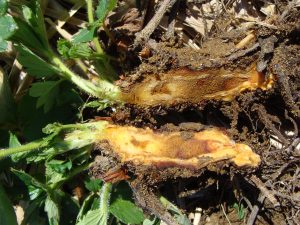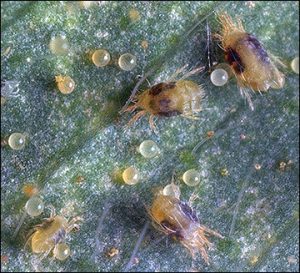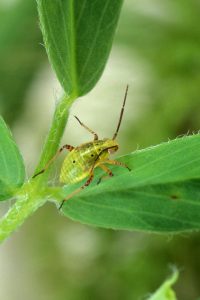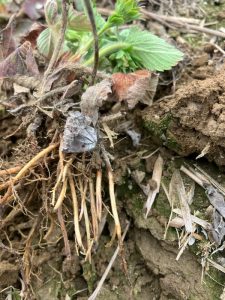Strawberry IPM Newsletter No. 1 – May 17, 2024
2024 STRAWBERRY PEST MANAGEMENT SEASON BEGINS
Vegetable and Berry Growers Twilight Meeting at Snell’s Family Farm, Buxton, June 13, 5:30 p.m.
Situation: Warm temperatures got strawberry plants off to an early start in fields that had straw mulch removed before the rain started. Cooler cloudy weather that has prevailed since, has slowed development to back to near normal for the season. Early flowering varieties such as Wendy, are showing a few blossoms in matted rows, especially where rowcovers were used, and many are showing frost injury (black centers) from the cold nights last week. No frost warnings for the next week, but growers should still be vigilant and be prepared to frost-protect their plants, if necessary.
We have begun scouting strawberry fields for overwintering insect pests, disease issues and winter injury. The results of our strawberry scouting will be reported through this newsletter until harvest time. You can also get quick access to this information through the UMaine Highmoor Farm news blog or the UMaine Pest Management web page. If you have questions about the Newsletter, please give us a call at 933.2100 or send an e-mail message to me at: david.handley@maine.edu.
Spring Growers’ Twilight Meeting: The Maine Vegetable & Small Fruit Growers Association will be having a Spring Twilight Meeting on Thursday, June 13, at 5:30 pm at Snell’s Family Farm, 1000 River Road in Buxton. John and Roberta Snell grow a wide variety of vegetables, apples and berries for their stand and CSA, and their daughter Carolyn runs a cut flower business from the farm.

Winter injury: Plants may be victims of winter injury if they appear weak or dead: especially in more exposed parts of a field, where mulch was not applied or where mulch was displaced by wind or animals. This is caused by freezing of the tissue in the crown of the plants, and therefore can be diagnosed by cutting into the crowns of the strawberry plants. The internal tissue will show dark brown discoloration. To reduce the impact of winter injury, make sure the plants get plenty of water, and apply nutrients to encourage root growth and flower development, which should include: nitrogen, calcium, and phosphorus. Heavy nitrogen fertilizer applications in the spring are not recommended, but up to 20 pounds of actual N (e.g. 125 lb. calcium nitrate) may improve early spring growth.
Spring Weed Management: Some growers were not able to make their typical dormant fall herbicide applications due to late heavy rains. Herbicides available for spring applications are very limited due to concerns about plant injury and harvest intervals. Dacthal® and Devrinol® herbicides are registered for use in the spring and can be very effective on annual grasses and some broadleaf weeds, but only have pre-emergent activity, i.e. will not control weeds already emerged. Other herbicides have some post emergent activity but may only be applied with a shielded sprayer to the areas between the plant rows, not directly over the plants, or injury is likely to occur. These materials include Chateau®, Prowl H2O®, Satellite Hydrocap®, and Aim®.

Two Spotted Spider Mites: I have found mites in nearly all fields we’ve scouted this week, but populations have mostly been very low and well under the control threshold. However, one southern field was over threshold, and it is important to note that mites reproduce rapidly under warm, dry conditions, and tend to be most prevalent in fields that were under rowcovers for the winter and/or early spring. Scout for mites regularly once the plants begin to grow. Spider mites mostly feed on the undersides of strawberry leaves. Infested leaves will develop yellow flecking and a bronzed appearance, and the plants become weakened and stunted. Fields that have had excessive nitrogen fertilizer and/or row covers tend to be most susceptible to mite injury. To scout for mites, collect 60 leaves from various locations in the field and examine the undersides for the presence of mites. Mites are very small – you may need a hand lens to see them. Chemical control options for two-spotted spider mites include Acramite®, Portal®, Nealta® Savey®, Zeal®, Vendex®, Oberon®, Brigade®, Danitol® and JMS Stylet Oil® (oils will cause plant injury if used in combination with captan or within 14 days of an application of sulfur).
Strawberry bud weevil: We have not observed any damage from “clippers” this week, but growers with fields coming into bloom should be on the lookout for this damage. Affected flower buds are clipped below the base and dangle from their stems looking wilted and brown. The small weevil can often be found within the flower clusters, laying eggs and feeding on pollen. Once the buds have opened, these insects no longer cause significant injury. The control threshold for clipper injury is more than 1.2 clipped buds per two feet of row. Sample at five locations in a field. Small holes in the petals of opening flowers indicates clipper feeding activity and is often first noticed in the border rows. Expect clipper damage to be most common in later blooming varieties. Insecticide options for clippers include Brigade®, Bifenture®, Danitol®, Sevin XLR Plus® and PyGanic®. Clippers will also attack the buds of raspberries and blackberries, although they do not usually cause significant injury.

Tarnished plant bugs: I have only seen one adult tarnished plant bug in a strawberry field this week, and no nymphs. The nymphs can be hard to find, especially if the plants are wet. Young nymphs are very small (2 mm), active, yellow-green insects. It is important to scout for them regularly, as they may appear very quickly as the weather improves. The threshold for plant bug nymphs is 4 or more flower clusters infested per 30 sampled. You don’t have to count the nymphs; just tap flower clusters over a plate or tray to knock any nymphs off. If any appear on the plate after tapping, count that cluster as “infested”. Start scouting any field with open flowers now. Insecticide options for tarnished plant bugs include malathion, Assail®, Brigade®, Bifenture®, Dibrom®, Danitol®, Closer® and PyGanic®.
White grubs: Weak growth noted in fields this spring may also be the result of white grubs feeding on the roots of newer plantings. These grubs are the larvae of beetles, including European chafer and Asiatic garden beetle. They differ from the larvae of black vine weevil and strawberry root weevil in that they have legs and a swollen anterior (rear end), and they tend to be larger. Their feeding weakens the plants by reducing the number of roots. The grubs can be found by pulling up weak plants and sifting through the soil that surrounds the roots. Controlling white grubs once they have become established in a field can be difficult. These tend to be more of a problem in new fields that have been planted following a grass rotation crop, because the adults prefer to lay their eggs in sod. Admire Pro® and Platinum® insecticides are labeled for control of white grubs and should be applied within two hours of irrigation or rainfall to be sure the chemical gets into the root zone. Admire Pro® requires a 14 day to harvest interval, while Platinum® requires a 50-day pre-harvest interval.
Cyclamen mites: I have seen some indications of cyclamen mite injury in fields this week, but it has not been widespread. Infested plants show weak growth and shrunken, crinkled leaves. These mites are very small and reside in the crown of the strawberry plant, feeding on the developing leaves and flower buds. They are very hard to see, even with magnification. Portal® miticide can be effective, but must be applied in lots of water to be sure that the material is carried down into the crowns where these mites reside.

Diseases: Bloom is a critical time to protect strawberry fruit against gray mold caused by the fungus Botrytis cinerea, especially when conditions have been damp. Two to three sprays of fungicide during bloom are typically required to provide good protection against this disease. Botrytis cinerea overwinters on old leaves and plant debris. Fruit infections take place almost exclusively through the flowers, so gray mold control efforts must be focused on the bloom period. If the bloom period is dry and/or good fungicide coverage is maintained, incidence of gray mold at harvest should be low.
Good fungicide choices for control of gray mold in strawberries include: Elevate® (fenhexamid) has good to excellent activity against Botrytis; Captevate® is a pre-mix of captan and fenhexamid and has a broader spectrum of activity than Elevate® alone; Switch® (cyprodinil and fludioxonil), Scala® (pyramethanil) and Pristine® (pyraclostrobin and boscalid) are also excellent products for gray mold control. Topsin M® plus captan is also a good fungicide combination. There has been some resistance developing to some of these products in the southern US, but so far all have worked well in New England.
The fungicides Cabrio® (pyraclostrobin) and Abound® (azoxystrobin) are NOT suitable for gray mold control, but are effective against anthracnose and other fruit rot and leaf spot diseases. All fungicides mentioned above have a 0-day pre-harvest interval, except Topsin M® (1 day). Remember to alternate fungicides with different modes of action for resistance management purposes.
Angular leaf spot: I have seen some angular leaf spot in strawberries this week. This is a bacterial disease that is characterized by translucent leaf spots that may turn yellow and eventually black. The symptoms tend to start on the lower leaves but may move upwards as bacterial spores are splashed up by rain or irrigation water. Infection of the calyxes may result in a blackening of the berry stems and caps, reducing their marketability. Bacterial angular leaf spot is favored by extended cool, wet weather and nights with temperatures close to freezing. Frequent irrigation for frost protection can greatly encourage the development and spread of the disease, as will extended cool, damp weather. Susceptibility to this disease appears to vary significantly between varieties. The copper-containing material Kocide®, can reduce the spread of this disease. Start spray applications before bloom to prevent multiplication of the bacteria on the leaves before they jump to the berry caps. Application of copper sprays after bloom can result in fruit injury and is not recommended. Hydrogen dioxide (OxiDate®) may also have some activity against angular leaf spot when used on strawberries as part of a gray mold management program.

Red Stele Root Rot: With the wet conditions last fall and this spring, growers should be alert for this root rot if any fields appear to be weak, stunted or dying. To diagnose red stele, pull up a few plants that look weak and scrape the roots of these plants to see if the center of the root, known as the stele, is rusty red in color, instead of the normal white. The red color would indicate an infection. Red stele is caused by Phytophthora fragariae, a soil pathogen that infects roots when soils are wet with temperatures around 50°F. The pathogen grows into the roots causing the plants to become weak, stunted and to eventually die. Symptoms are most evident in the spring and can be mistaken for winter injury. Ridomil Gold®, Alliette® or Phostrol® are fungicides that can be applied in the early spring for control of red stele. In newly planted beds, RootShield® may be applied as a pre-plant root dip to help prevent infections. Many varieties have some level of resistance to the disease, but the most effective management strategy is to plant only into well-drained soils, and/or plant onto raised beds.
2024-2025 New England Small Fruit Management Guides: A printed version of the new edition of the Guide is now available through our office. The cost of the Guide is $25, including shipping. You can request a copy by sending a check made out to “UMaine Cooperative Extension” to our Highmoor Farm address below. Members of the Maine Vegetable & Small Fruit Growers Association will receive a copy as a benefit of membership. The latest edition of the Guide is also available free online at 2024-2025 New England Small Fruit Management Guides.
The best way to manage strawberry pests is to scout your own fields regularly and often. You should begin to scout as soon as flower buds emerge from the crowns and continue to monitor the plantings one or two times per week up until harvest.
Sincerely,
David T. Handley
Vegetable & Small Fruit Specialist
Highmoor Farm
P.O. Box 179
52 U.S. Route 202
Monmouth, ME 04259
207.933.2100
UMaine Extension Diagnostic Research Lab
Pest Management Unit
17 Godfrey Drive
Orono, ME 04473
1.800.287.0279
Where brand names or company names are used, it is for the reader’s information. No endorsement is implied nor is any discrimination intended against other products with similar ingredients. Always consult product labels for rates, application instructions and safety precautions. Users of these products assume all associated risks.
In complying with the letter and spirit of applicable laws and pursuing its own goals of diversity, the University of Maine System does not discriminate on the grounds of race, color, religion, sex, sexual orientation, transgender status, gender, gender identity or expression, ethnicity, national origin, citizenship status, familial status, ancestry, age, disability physical or mental, genetic information, or veterans or military status in employment, education, and all other programs and activities. The University provides reasonable accommodations to qualified individuals with disabilities upon request. The following person has been designated to handle inquiries regarding non-discrimination policies: Director of Equal Opportunity, 5713 Chadbourne Hall, Room 412, University of Maine, Orono, ME 04469-5713, 207.581.1226, TTY 711 (Maine Relay System).
